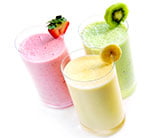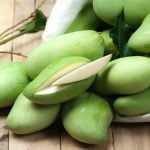

“Fruit juices and smoothies contain ‘unacceptably high’ levels of sugar,” reports The Guardian. That was the stark conclusion of a new study looking at the sugar content of fruit juices and smoothies marketed at kids in the UK.
Of the 203 kids’ drinks the researchers checked from major supermarket shelves, most (117, 58%) would receive a Food Standards Agency red colour-coded label for sugars per standardised 200ml serving.
But not all drinks were laced with lots of sugar – around a third would have attracted a green Food Standards Agency label, meaning the sugar levels were less of a worry.
The bad news is that 85 juices or smoothies (42%) contained at least 19g of sugars – the equivalent of 4¾ sugar cubes, or roughly a child’s entire maximum daily amount of sugars. Juices are currently exempt from the sugar tax announced earlier this month.
Only single-portion cartons were analysed in this study, and only those specifically marketed at children. Sugar-sweetened drinks, sports drinks and iced teas were excluded. So were cordials – the type you mix with water. This means the survey doesn’t cover the full range of sugar-laden drinks children may have.
For parents looking to avoid giving their kids sugary drinks, it seems fruit juices and smoothies can’t be considered safe ground – pre-made and shop bought ones, anyway. Checking the sugar content on the label is the most practical solution. The zero risk approach is water.
There are much healthier ways to make sure your kids get their 5 A DAY.
Contents
Where did the story come from?
The study was carried out by researchers from the University of Liverpool and the University of London, and received no specific funding.
It was published in the peer-reviewed BMJ Open. The study is published as an open access article, which means it’s free to read and download online.
The media generally reported on the story accurately, stressing that despite the high sugar content of many fruit juices and smoothies, the drinks are exempt from the sugar tax announced earlier this month.
This story may stimulate lively debate around improving labelling for kids’ food and drink, reformulating kids’ food, and whether a tax on fruit juices would help. Sugar issues tend to spark strong opinions on both sides, and this is unlikely to be any different.
The title of the research article was “How much sugar is hidden in drinks marketed to children?”, which is a bit naughty. The food industry would reasonably argue there is nothing “hidden” about these sugars, as the sugar content – as with other ingredients – is labelled on the packaging.
In fact, that’s where the researchers got their sugar content information from to do the study. Whether people read or understand the labels – especially kids – is potentially the more important point.
What kind of research was this?
This cross-sectional analysis investigated the free sugar content of fruit juice, juice drinks and smoothies marketed at children in the UK and readily available to buy at most major supermarkets.
What are free sugars?
The research team provide a clear definition:
“‘Free sugars’ refer to monosaccharides (such as glucose, fructose) and disaccharides (such as sucrose or table sugar) added to foods and drinks by the manufacturer, cook or consumer, and sugars naturally present in
honey, syrups, fruit juices and fruit juice concentrates.”
It’s a term used to distinguish between added sugar and the sugars naturally present in fully unrefined carbohydrates, such as fruit.
The research team said that, “Consumption of free sugars, particularly in the form of beverages, can lead to an increase in total sugar intake and a reduction in the consumption of more nutritionally valuable food, thus leading to an unhealthy diet, increased weight and risk of non-communicable diseases”. High-sugar foods and drinks are also a major contributor to rotting children’s teeth.
Referring to studies that show adults vastly underestimate the sugar content of fruit juices and smoothies, the research team were also worried parents might be swapping fizzy drinks – largely accepted to contain lots of sugar – with fruit juices.
Juices may be perceived to be the better option, but potentially have a similar sugar content but without the nutritional benefit of whole fruit.
The study investigated the sugar content of fruit juices most readily available on UK shelves and targeted at children to see whether they were anything to be worried about.
What did the research involve?
The study recorded the labelled sugar content of 203 fruit juices, juice drinks or smoothies on the shelves of the UK supermarkets Tesco, Asda, Sainsbury’s, Marks & Spencer, Waitrose, The Co-operative and Morrisons.
Supermarket own-brand and branded drinks were included. Sugar content was presented per 100ml and 200ml servings. The 200ml option is the most common carton size for kids, giving a better idea of the actual amount of sugar they would drink in a single serving. The content per 100ml is more useful to allow comparisons across different-sized products.
Only single-portion cartons were recorded, and only those specifically marketed at children. Sugar-sweetened drinks, sports drinks and iced teas were excluded. So were cordials – the type you mix with water.
The reason given for excluding cordials was that although they are marketed at children, they are not single-serve portions, which was the focus of this work.
Fruit juice, juice drinks and smoothies followed the British Soft Drinks Association definitions:
- fruit juices – “100% pure juice made from the flesh of fresh fruit or from whole fruit, depending on the type used. It is not permitted to add sugars, sweeteners, preservatives, flavourings or colourings to fruit juice.”
- juice drinks – “1% to 99% juice, nectars, still flavoured waters, sports drinks and iced teas”. Note: neither sports drinks nor iced teas are marketed at children, so were not included in the study.
- smoothies – those labelled as “fruit juice” should not include any additional ingredients and are subject to the same regulations as fruit juice. Non-pure fruit smoothies may contain other ingredients, such as yoghurt or milk, which must be labelled.
What were the basic results?
The researchers identified 203 drinks marketed at children in total: 21 fruit juices, 158 juice drinks and 24 smoothies. Sugar content ranged from 0-16g per 100 ml. Taking a standard sugar cube to be 4g of sugar, this meant the maximum was four sugar cubes per 100ml.
The average sugar content was 7.0g per 100ml – 1¾ cubes – but among the 100% fruit juice category, it was higher, at 10.7g per 100ml – two to three sugar cubes.
Smoothies (13.0g per 100 ml) contained the most sugars at around 3¼ sugar cubes per 100ml, while juice drinks (5.6g per 100ml) contained the least, about 1.5 cubes.
Most of the 203 drinks studied (117, 58%) would receive a Food Standards Agency red colour-coded label for sugars per standardised 200ml serving – the amount kids are most likely to drink. Just 63 (31%) would receive a green colour-coded label.
Eighty-five products (42%) contained at least 19g of sugars (4¾ cubes) – basically a child’s entire maximum daily amount of sugars.
In terms of types of sugars, 57 products contained sugar (sucrose), 65 contained sweeteners with no calories, and five contained both. Seven contained glucose-fructose syrup.
How did the researchers interpret the results?
The researchers concluded that, “The sugars content in FJJDS [fruit juice, juice drinks and smoothies] marketed to children in the UK is unacceptably high. Manufacturers must stop adding unnecessary sugars and calories to their FJJDS.”
Conclusion
This study showed the sugar content of fruit juice, juice drinks and smoothies marketed at kids in the UK can be high and, in many cases, one drink carton as sold can be their entire maximum daily allowance of sugar.
More than half would have attracted a Food Standards Agency red colour-coded label for sugars. But not all drinks were laced with lots of sugar – around a third would have attracted a green Food Standards Agency label, meaning their sugar levels weren’t a worry.
The study applied to products in big supermarkets in the UK today. Lower sugar alternatives might be on the way given the recent sugar tax, but this isn’t guaranteed.
Fruit juices and smoothies are exempt from the sugar tax, but could be scooped up in the drive to reformulate to lower sugar products, particularly if public pressure mounts.
The portion size of the drinks wasn’t a major focus of the study, and could be very important. While the per 100ml sugar content is useful to compare different drinks, it is small and many portions are much larger, so kids could be consuming a lot more sugar than these standardised portion sizes indicate.
Also, as the study was focused on juices and smoothies targeted at children, it won’t give a reliable indication of the amount of sugar-laden drinks children may be consuming, including squash and soft drinks.
Sugar studies tend to attract lots of heated debate and are popular in the news. Last summer the government followed independent scientific advice to reduce the maximum recommended sugar intake by half. Most UK adults and kids consume considerably more than this recommendation.
Read more about reducing your sugar intake.
The study serves to highlight that fruit juices, drinks and smoothies as a group can’t be considered a low-sugar healthy drink on their own or to be a healthier swap for high-sugar fizzy drinks by default. Both fizzy drinks and juices can be very high in sugar; both fizzy drinks and juices can contain zero sugar.
For confused parents looking to do the best by their kids, the message seems to be don’t assume fruit juices are low sugar and always check the label to find out.
Whole fruit is the healthier alternative because it gives your child the fibre in the fruit, which is often missing in the juice.
For parents looking to avoid sugary drinks, it seems fruit juices can’t be considered safe ground. The zero risk approach is water.
[Source:- NHS]




